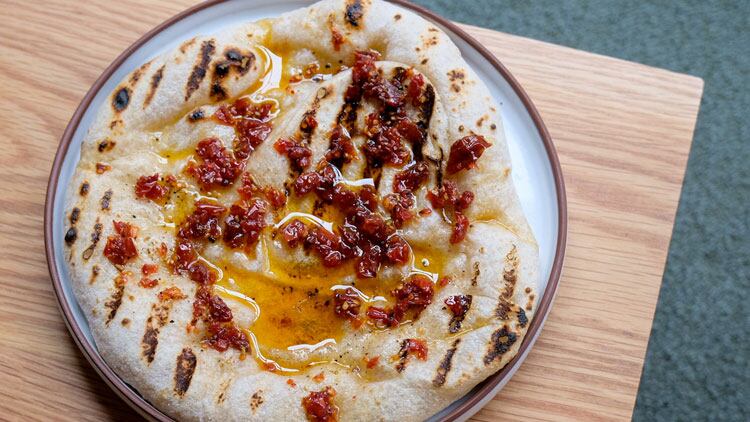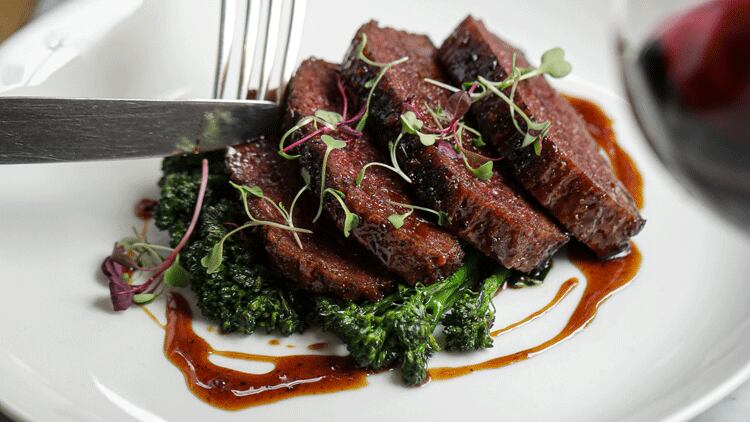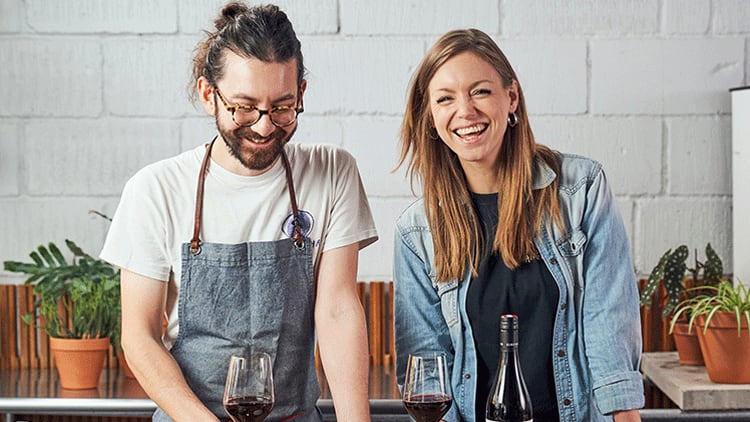Gourmet kids menus
Could 2023 be the year that restaurants fully embrace a much younger demographic? Casual dining restaurants have been targeting the parent pound for many years, often giving food away for free in order to pull in full-paying adults. But it seems that more upmarket restaurants looking to fill dining rooms at lunchtimes and early on in the evening are rethinking their offering for both anklebiters and Nintendo Switch-absorbed older kids. In January, Apricity chef Chantelle Nicholson will launch Culinary Kids, a tasting menu especially created for youngsters in partnership with charity School Food Matters. The £32 five-course menu showcases the kitchen’s progressive sourcing policies and zero-waste approach. “We are so aware that some kids might not know where things come from, be it a root vegetable or a cut of meat they have never seen before, we would love to open their eyes and taste buds,” says Nicholson, who is also offering a series of hands-on cooking sessions for kids aged between eight and 12 at her Mayfair restaurant. A postcode or so away in Fitzrovia, Pied à Terre executive chef Asimakis Chaniotis has also created a tasting menu for little people. The Petit Complet includes a mocktail, snacks, bread and three courses, plus petit fours and a babycino, all priced at £40 per child. If requesting that kids sit still for more than 30 minutes in a restaurant feels like a bit of an ask, Fallow is offering a quicker experience with its recently launched Mini Fallowers menu, which includes smoked beef ribs; homemade sausages with new potatoes and gravy; and chocolate soft serve. The kids are alright, it seems.
The Martini

OK, so the Martini isn’t exactly a new drink - it’s been around in its most recognisable form for over 100 years, in fact - but the notoriously strong cocktail is once again hitting something of a purple patch. Whether as a punchy antidote to the raft of low and non alcoholic drinks that have flooded the drinks category over the past year or just a way to temporarily blur the edges of the current economic crisis, the Martini looks set to take over from the Negroni as the de facto drinks option for restaurants in 2023. Don’t just take out word for it; at his newly-opened Velvet bar at The Corinthia, Salvatore Calabrese has created seven versions of the ‘king of cocktails’, including the Sesamini, made with Nikka Coffey gin washed sesame oil, crème de banane, and mancino secco; and a Salty Martinin made with Tanqueray No 10, dry fino sherry, and caper brine. Then there’s the new Dishoom at Canary Wharf that is channelling a Gordon Gekko ‘lunch is for wimps’ vibe with its three Martini lunch offer. When the economy is crumbling around you, nothing deadens the pain like a Martini.
Restaurants reducing menu sizes

Staring down the barrel of what is probably going to be its toughest winter of trading in living memory – which is really saying something given the last two years – restaurants across the country are doing everything they can to contend with the double whammy of ongoing staff shortages and rising food prices. The latest Future Shock report found that more than a third of hospitality businesses (35%) plan to simplify menus because of staff shortages. And trade body UKHospitality has said that offering shorter menus is one of a number of ways restaurants are trying to make ends meet. They include modern British restaurant Copper & Ink, led by chef Tony Rodd, in London’s Blackheath, which has reduced its à la carte menu to a total of nine dishes (three starter, three main and three dessert). And according to Rodd, the decision had been well received by customers. “Reduced waste, increased quality. Win win,” he wrote on Twitter. Another planning to cut the number of dishes is Sam Harrison, owner of Sam’s Riverside in London’s Hammersmith. “Tight ship going to be needed this winter,” he said. “No room for error or wastage.”
Competition in the new wave Thai sector heats up

London’s new wave Thai scene is already pretty spicy thanks to the likes of Kiln, Som Saa, Farang, The Begging Bowl and the JKS Restaurants-backed Luke Farrell but 2023 is set to see a fresh surge of new concepts from both new and established names. After a few years running pop-ups, John and Desiree Chantarasak will open a permanent iteration of AngloThai on Fitzrovia’s Eastcastle street backed by MJMK. The concept will be quite different from the capital’s current crop of new wave Thai restaurants serving more subtle dishes and in some cases subbing in British aromatics for Thai ones. The philosophy and market positioning won’t be too far away from MJMK’s Michelin-starred KOL restaurant down the road in Marylebone, in fact, which is an exciting prospect indeed. Farrell, meanwhile, is expected to launch a restaurant that explores the cuisine of Northern Thailand having shaken up London’s Thai scene with the Southern Thai cuisine-focused Plaza Khao Gaeng and the more recently opened Speedboat Bar, which is inspired by Bangkok’s Chinatown. Last - but by no means least - the godfather of forward-thinking Thai cookery David Thompson will finally bring his Long Chim restaurant to London. The chef and Thai food expert – who trained many of the chefs now making waves in London and beyond with Thai food - will launch a large restaurant in Chinatown’s Dolphin Yard. Looks like the heat is on.
The rise of the flatbread

Ok, sure – flatbreads are by no means a new phenomenon. In fact, they’ve been a culinary staple for millennia. But creative chefs are ushering in a gastronomically ambitious era for the flatbread. A symptom of the ever-growing trend towards small plates, flatbreads benefit from being easy to share and simple to prepare (the dough typically being unleavened). Their cost-effective nature also allows chefs to use high-quality toppings without pushing the price point too far. Take Straker’s, which recently launched in London’s Notting Hill with a signature flatbread topped with scallop and burnt chilli butter. Then there’s Will Sutton and Patrick Withington’s low-key yet highly rated Manchester restaurant Erst, which always has a couple of topped flatbreads on the menu. Costing just £6 each, current options include beef fat and Urfa chilli; and walnut tarator with brown butter and sage. And let’s not forget Fallow in London’s St James's, which often has a dedicated flatbread section on its menu. With the appetite for small plates showing no signs of abating and a need for menus to remain accessible as the country contends with the cost-of-living crisis, you can bet that we’re likely to see more flatbread dishes on offer in the months to come.
The roadside dining renaissance

Those still mourning the death of the Little Chef brand have plenty of reason to look on the bright side in 2023, thanks to the launch of the aptly named Brightside. The new roadside dining brand will be the latest addition to the Loungers group portfolio and is set to open its first site on the A38, south of Exeter, in February 2023, with two additional southwest of England locations to follow quickly in the spring. Looking to fill the void left by the demise of brands such as Little Chef and Happy Eater, Loungers says it sees great potential to reinvigorate roadside dining in the UK, a once important part of the UK’s on-the-go dining sector that has dwindled over the past few decades. And it’s not the only group banking on a roadside dining renaissance. Upmarket hotel and diner brand Mollie’s Motel & Diner has announced plans to expand to around 100 sites over the next 10 years with its formats, which include roadside locations with around 75 bedrooms and a 145-cover diner. Meanwhile, fast-casual restaurant brand PizzaLuxe has said it is looking to ‘shift the stigma’ around what restaurants in the travel space can offer with expansion planned across the UK’s motorway network in the coming years.
Elevated sides

You don’t need to be Nostradamus to predict that diners’ wallets will continue to be hit next year amid the continued rising cost of living and savvy restaurateurs are having to come up with innovate ways to get people to part with their money when eating out. One tactic likely to rise in prominence in 2023 is the creation of super premium sides, giving diners the option to elevate their meals if they so choose but enabling mains to stay reasonably priced to entice people through the doors. Research from Lumina in November found that while restaurant groups are largely keeping their existing menu prices the same despite inflationary pressures, newly introduced side dishes are on average 23% more expensive (new starters are 14% more expensive). Caviar and truffles have long been offered as optional extras to those who can afford it but in 2023 we expect to see traditional sides also given makeovers and featuring more expensive ingredients to encourage people to splurge when they want to.
The proliferation of the ‘grocerant’

The pandemic opened many a restaurant’s eyes to the benefits of having a retail side hustle. Now, in 2023, a well-stocked deli looks set to be a must-have accessory for ambitious chefs. In London, Ombra founder Mitshel Ibrahim will open a bakery, ‘pastificio’ and deli under the arches next to Regent’s canal, the team behind Herne Hill’s Llewelyn’s will open a deli and shop next door, and Dalston-based chef Oded Oren will launch a eponymous delicatessen in Broadway Market selling his silky homemade hummus and restaurant meals to heat up at home. And it’s not just the capital. Following the success of their first ‘grocerant’ at Sheffield’s Cutlery Works, the founders of Jöro will open a second Shöp in the city. A key part of the redevelopment of Sheffield’s Oughtibridge Paper Mill, the new venture is set to launch later this year and will retail the high quality Yorkshire produce, natural wines, charcuterie, cheeses, coffee and toiletries used by Luke French and Stacey Sherwood-French in their restaurants. In common with Lulu’s, the second iteration of Shöp will morph into a wine bar in the evening offering lighter dishes. In tough times, operators finding new revenue streams that better sweat their assets is something worth raising a glass to.
3D printed meat

Printed meat might sound like it comes from the same camp as the meal-in-a-pill innovation that has intrigued sci-fi lovers for decades, but not only is it a reality it looks likely to reignite interest in plant-based meat alternatives, which cooled somewhat in 2022. The main protagonist in the field of printed meat is Israeli food tech company Redefine Meat, which launched in 2018 and which has spent the past four years developing ‘meat’ products using 3D printer technology. In simple terms, the company uses protein sources including soy, wheat, chickpeas to mimic the ‘muscle’ element of meat, and coconut fat, cacao butter, canola oil for the fat element, and cranberry and beetroot juice for the ‘blood’ to create the product’s three components, which are then very precisely produced layer by layer resulting in a texture remarkably close to that of meat. Most impressive are the products that go head to head with meat cuts, such as lamb and beef flank, sriploin and tenderloin as well as lamb koftes. Redefine has started with restaurants before moving into retail in the UK, with venues serving it that include Marco Pierre White Steakhouse, London steakhouse Gillray’s, German Gymnasium, and Gauthier Soho. “We started with a love for meat but also an understanding that we can’t continue with the way we consume meat today,” says Edwin Bark, Redefine Meat’s senior vice president. “We want to outperform the cow to deliver a piece of meat that is better than the animal with the aim of building the largest meat company in the world.” Die hard meat fans might not bite, but for steak lovers looking to reduce their meat content, 3D printed meat could be answer.
Restaurants turn to crowdfunding to fuel growth

It looks like the era of cheap money is over. Prior to the pandemic, independent restaurateurs looking to establish their first site would often turn to bank loans or perhaps chase angel investors to secure the capital needed to get their foot on the commercial property ladder. But with inflation pushing up interest rates, the cost of borrowing money has risen; businesses don’t want to saddle themselves with unserviceable levels of debt and both banks and investors are becoming more particular about who they give their money to. As such, we’re seeing more and more operators turn to their own customers to try and secure the funds needed to fuel their growth. Now, of course, crowdfunding isn’t a new trend within hospitality, but what’s notable is the amount of businesses of all shapes and sizes that are turning to it. High-profile examples include Sonora Taqueria, which recently exceeded its crowdfunding target of £65,000, paving the way for it to open its first permanent restaurant next year in London’s Stoke Newington. There’s also chef Ferdinand ‘Budgie’ Montoya, who is preparing is to launch an online equity crowdfund to open a permanent site for his modern Filipino restaurant Sarap. It’s not just emerging restaurateurs, either. Gary Usher, a pioneer of the crowdfunding model, recently raised more than £220,000 via a Kickstarter campaign to support the opening of his restaurant group’s first pub site; while London-based pasta group Bancone has raised more than £700,000 via an equity crowdfund on Crowdcube to support its own plans for growth.




